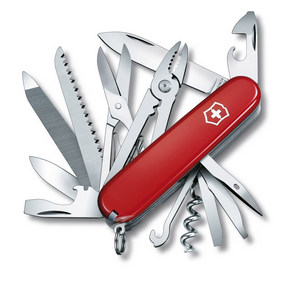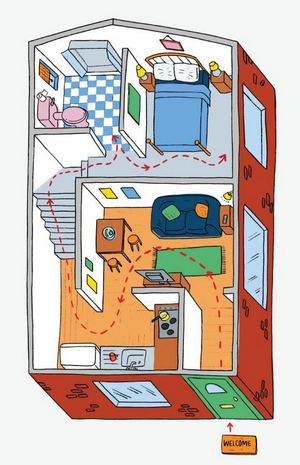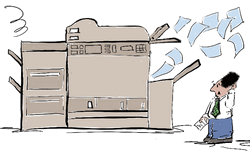The Journey Method
 The Journey Method is one of the most useful memory techniques you can learn. It is, at the same time, both very simple and very comprehensive. It can, in fact, seem ridiculously simple, to the extent that you don’t really see the point of using it. That would be a huge mistake; the Journey Method, used correctly, is a wonderfully comprehensive memory method that you can tailor to your own specific needs. It’s like the Swiss army knife of the memory world!
The Journey Method is one of the most useful memory techniques you can learn. It is, at the same time, both very simple and very comprehensive. It can, in fact, seem ridiculously simple, to the extent that you don’t really see the point of using it. That would be a huge mistake; the Journey Method, used correctly, is a wonderfully comprehensive memory method that you can tailor to your own specific needs. It’s like the Swiss army knife of the memory world!
What exactly is the Journey Method?
Actually, you might be more familiar with the other name it goes by; it’s often called the Memory Palace. A grand name for something so simple, but the fact is, it can be as grand as you care to make it. It’s not a new idea; in fact, it probably goes back thousands of years.
The Greek myth of Theseus and the Minotaur includes the method that Theseus used to escape from the labyrinth; Princess Ariadne, daughter of King Minos, gave him a thread and advised him to unravel it as he went along so that he could retrace his steps. This simple technique saved him, and it’s not unlike the Journey Method.

A memory journey can be as simple as a stroll through your own house. Or it can be a much more detailed expedition through a foreign capital, taking in all the tourist sites and a few of the more intimate little dives and haunts, the ones that most tourists  never get to see. It can be short or long, simple or complex, straightforward or exhaustively detailed. It can be factual or fanciful. It can be totally imaginary, if that suits your purpose and your mentality.
never get to see. It can be short or long, simple or complex, straightforward or exhaustively detailed. It can be factual or fanciful. It can be totally imaginary, if that suits your purpose and your mentality.
It can be anything and anywhere. It’s almost as other-worldly as Dr. Who’s TARDIS, and it could actually be based on that, if you decide that would be a good idea. Or it could be situated on a space station, or a moon base. Or inside a crater on a moon of one of the outer planets. The only rule is that you have to be happy about using it, and confident that it makes some sort of sense to you.
But what are the rules? There must be rules, right?
The only rules of memory journey creation are these:
- The journey should be easy to remember
- You should always proceed along the journey in the same manner
- It should be somewhere interesting to you
- It should provide ample stages where you can leave mementos
- You should make notes about your memory journeys
And that’s about it. Apart from those few simple guidelines, you’re free to create any journey you might have in mind.
So what makes a good memory journey?
A good memory journey would ideally be somewhere you’re very familiar with. There’s no point in trying to use a place you’re not already familiar with; that would just be flying in the face of common sense.
It makes sense to use your own house for your first memory journey. It’s a place you’re already intimately familiar with. You know every inch of the place, every nook and cranny. And nooks and crannies are particularly useful stages on any journey. Make use of them!
Once you’ve used your House Journey, feel free to use other people’s houses, or shops and businesses you’re familiar with. Public buildings, such as hospitals, schools, council chambers, museums, art galleries, department stores, and so on … they all provide endless possibilities for memory journey creation.
And for each one you create, you need to make detailed notes about the journey. It’s no good creating a detailed memory journey and, when you come to use it three months later, you can’t remember the details of it. That’s no good at all! If a memory journey is to be of any use to you, it’s worth making notes about. It’s worth setting the whole thing ‘in stone’, so to speak. Anytime you need to use the journey, it will be there, ready for you to become reacquainted with it.
So, how do I use it?
 The idea is very simple. The journey itself is well known to you already, or you’re prepared to make it well known to you through practice. So you’re starting with something already remembered. Your job, then, is to place things along that easily remembered route, in such a way that you can find them next time you travel that same journey. I told you it was simple!
The idea is very simple. The journey itself is well known to you already, or you’re prepared to make it well known to you through practice. So you’re starting with something already remembered. Your job, then, is to place things along that easily remembered route, in such a way that you can find them next time you travel that same journey. I told you it was simple!
You just leave a trail of stuff that is really, really easy to follow, since you’re so familiar with the route already, and ‘walking’ that trail will reveal all the things you need to remember. Simple! It’s so simple, you might want to think of it as the Magic Memory Journey Method!
Let’s try the House Journey then …
Great idea! We’ll start at the front door. That becomes the first stop on the journey. The hallway might be the second stop. The front room becomes the third. The kitchen becomes the fourth. The stairs would be fifth. Sixth could be the main bedroom. Seventh, the second bedroom. Eighth would be the bathroom. Ninth might be the loft. Dart downstairs to the back door for stop number ten.
 So you’d make a note of this journey like so:
So you’d make a note of this journey like so:
House Journey
- Front door
- Hallway
- Front room
- Kitchen
- Stairs
- Main bedroom
- Smaller bedroom
- Bathroom
- Loft
- Back door
That gives you a neat little journey of ten stops, or stages. And anytime you need to remember ten items (or fewer than ten) you could easily use this journey. You would simply leave a lasting impression of the items at the various stages.
A lasting impression?
Yes, that’s a very important point of this whole memory technique. If you had to memorise ten things and you just imagined them at the various stages, it wouldn’t work very well. You might assume it would, but trust me, you’d be disappointed. For this technique to work, you have to make things unusual in various ways.
You can make them ridiculously large, or animated in some way (maybe suddenly, or violently), or made of some unusual material, or interacting with other things in some very weird or unusual ways. Anything you can come up with to make the things more memorable, that’s fine.

Why? Because your brain isn’t going to be impressed with a series of very normal things. It sees normal things all day long, and it knows that normal things are usually not really important enough to be remembered. The more unusual things seem, on the other hand, the more worthy of remembering they become.
So the standard thing is to make these things (the things you need to memorise) very strange and unusual in some way. This makes the brain perk up and take note! It loves strangeness and unusualness. It signifies importance! And it doesn’t even mind if you flout the laws of physics, or good taste, or anything else, for that matter. As long as the thing becomes odd (and consequently memorable) then the brain is almost guaranteed to perk up and take note.
If it’s so good, let’s see a demo!
That’s a great idea, because I can tell you’re not convinced 🙂
Let’s say you’ve got a busy day ahead. Several things to take care of, and your mind’s all over the place. You’re already imagining the danger of getting through the day and suddenly realising you’ve forgotten to take care of something really important. Then you remember the magic of the memory journey! So you decide to use the House Journey and place little reminders at the stages along the way.
Let’s list the things you need to remember …
- You’ve promised to write to Jack, your seven-year-old nephew. He loves getting a letter and it’s about time you wrote that letter you’ve been putting off for a couple of weeks.
 You need to renew the tax on your car. It runs out in a week or so, so you have to make sure you get that done, it’s important.
You need to renew the tax on your car. It runs out in a week or so, so you have to make sure you get that done, it’s important.- You’ve got to fix the printer. You promised to print those knitting patterns for your friend Marcie, and she’s waiting for them.
- Oh, find a few spare minutes to trim your fingernails. You keep saying you’ll do it but you know, things just keep getting in the way of doing it somehow. Unless you’re planning to audition for the long-awaited sequel to The Wolfman, it’s about time you took care of this!
- Finish that book on understanding the internet. It’s a Dummies book and you’ve scanned through most of it (and even understood a few bits, here and there!), but you want it finished; you’ve been dropping into it and grabbing the basics of a few chapters here and there and it’s starting to annoy you now.
- Arrange a dental appointment. You’ve been meaning to get that dental work done for quite a while, and not having taken care of that is becoming a pain. Not quite as bad as actual toothache, but then what is??
- Call in at the gym. Look, it doesn’t matter if you only manage ten minutes training, at least it’s a start. You’ve been promising yourself you’d get back in shape and let’s face it, the mirror never lies … you need to get some gym work done and that’s all there is to it.
 Grab something from the supermarket for that anniversary meal. You know she thinks you should have been a chef and she really loves it when you cook a beautiful meal, so don’t disappoint her. And don’t come home with fish and chips!
Grab something from the supermarket for that anniversary meal. You know she thinks you should have been a chef and she really loves it when you cook a beautiful meal, so don’t disappoint her. And don’t come home with fish and chips!- Phone the vet about Euclid. He’s been a great cat and let’s face it, he’s probably on the home straight now. Better discuss it with the vet and if he says it’s kinder to let him go, just bite the bullet and have him take care of it. And remind her that if we ever get another cat, you get to choose the name!
- Trim that tree back in the back garden. If that neighbour keeps complaining about it ‘stealing her light’ you’ll forget you’re a gentleman one of these days and … well, it won’t end well, that’s all I’m saying.
Wow, no wonder you’re thinking you might forget to take care of something, there’s so much stuff to do, and it’s so varied. How the hell are you going to remember all that? Looks like you need a memory technique to manage such a thing …
Journey Method to the rescue!
- Okay, you’re at the front door … you’re trying to put the key in the keyhole and your nephew is stopping you; he’s pushing the key to one side. He’s saying “Write me a letter … aw, go on, don’t be mean!” Every time you try to push the key in the lock he jumps up and pushes it away. “It doesn’t have to be a long letter,” he says, “just one like this” and he produces a very l-o-n-g letter, about eleventeen pages, all double sided, and all about three times as big as normal letter size. He’s shoving the monster-sized pages in your face and whining about you being mean. You try to fit the key in the keyhole again and he kicks you in the shin, the little——— . I guess you’d better write him a letter.
- You’re in the hall now. There’s an angry looking policeman standing there, holding his open palm up in front of you. He’s staring right in your face and warning you that he’s checked your car and found it untaxed – if he sees it again and it’s still not taxed you’re going to get a ticket. Damn … that’s a sharp reminder!
 You squeeze past the officer and go into the front room. Shockingly, there’s a huge printer taking up most of the floor space, some of its panels dented and loose, and it’s smoking and clattering and spewing out dozens of sheets of blank, ink-stained paper. My guess is it’s not functioning at 100% efficiency! Now there’s a job that needs taking care of!
You squeeze past the officer and go into the front room. Shockingly, there’s a huge printer taking up most of the floor space, some of its panels dented and loose, and it’s smoking and clattering and spewing out dozens of sheets of blank, ink-stained paper. My guess is it’s not functioning at 100% efficiency! Now there’s a job that needs taking care of!- Now that you’ve been reminded about the letter, the car tax, and the malfunctioning printer, you head off into the kitchen. Hardly surprising really, you probably need a cup of tea after all this commotion in the house. No such luck though … the kitchen is set up like a beauty salon and there’s a really striking young lady waiting for you. She’s in a cute little uniform, mini-skirted and space-agey, and she says she’s waiting to take care of your fingernails. How could you go around with your nails in such a state, she says, tut-tutting and fluttering her unfeasibly long eyelashes. Sit down, you naughty boy, she beckons, and suddenly, for no apparent reason, you’re really looking forward to a session in the salon.
- You head for the stairs … no doubt there’s other reminders waiting for you up there. But your way is blocked by a huge book, it must be at least seven feet tall and two feet thick. It’s balanced precariously against the banister and you’re faced with the title of the book screaming DUMMIES at you. You try squeezing past the book without dislodging it, but it overbalances and crashes over the banister to the floor of the hallway. Damn, whatever happens to it, it’s always in the way. You’ll just have to finish the damn book and have done with it.
 You push open the door of the main bedroom and see a scary-looking dentist staring maliciously at you, a buzzing dental drill in his hand, poised and ready. You try to ignore the starched white tunic he’s wearing, mainly because it’s as blood-stained as a butcher’s apron, and you back away and out of the bedroom. Not scared, of course … just cautious.
You push open the door of the main bedroom and see a scary-looking dentist staring maliciously at you, a buzzing dental drill in his hand, poised and ready. You try to ignore the starched white tunic he’s wearing, mainly because it’s as blood-stained as a butcher’s apron, and you back away and out of the bedroom. Not scared, of course … just cautious.- You stumble across and practically fall into the smaller bedroom, still reeling from the shock of the psychotic dentist, and you’re immediately sliding and grabbing for something to cling to … the entire bedroom floor is one huge treadmill and you’re suddenly on it, and its speed is increasing wildly and uncontrollably. Oh my … you’d better get to a gym soon, even this mental apparition of a gym-from-hell is more than you can handle right now, in your sad physical state. You’ve simply got to get in shape!
 You drag yourself from the bedroom of gym-hell and make your way to the bathroom. She’s in there, your beloved, and she’s not looking pleased. In fact, she’s looking decidedly grim. You’ve given her fish and chips and she’s so disgusted she’s slapping you across the face with a slippy, raw, dead fish, ice cold from the supermarket fish counter. Maybe this is a reminder you need to come up with something better than fish and chips, you reckon?
You drag yourself from the bedroom of gym-hell and make your way to the bathroom. She’s in there, your beloved, and she’s not looking pleased. In fact, she’s looking decidedly grim. You’ve given her fish and chips and she’s so disgusted she’s slapping you across the face with a slippy, raw, dead fish, ice cold from the supermarket fish counter. Maybe this is a reminder you need to come up with something better than fish and chips, you reckon?- You can’t get out of the bathroom fast enough and you practically slide straight up the loft ladder. The whole loft is silent and it’s draped out like a chapel of repose. As you step off the ladder, you see Euclid, and he’s being tended by the vet, who’s looking sadder than a mortician who’s just been given two weeks to live. You realise you absolutely have to see about that poor cat’s state of health, and do it today.
- In a flash, you’re out the back door and setting a step ladder up against the tree. Over the fence, you’re faced with your neighbour, who’s arms are crossed determinedly and whose expression can best be described as silently furious. Oops! You’re gonna have to rush back in for the long-handled branch loppers, or face the fury that awaits you across the great divide.
Now that took me a lot longer to write than to come up with the ideas. I had to translate those ideas into specific images and scenes, and I had to think how best to express them in words, and I even had to go over it to make it more readable and to fix a few mistakes (there’s always a few mistakes!!). When you’re doing this for yourself, and not to demonstrate the technique to someone, you’ll be able to do it faster, no doubt about that.
And after using the technique yourself a few times you’ll be amazed how quickly you can make good use of it. You’ll be able to dream up weird and wonderfully memorable little scenes, full of oddly-made and weirdly-huge items, and peppered with anger and haste and sexiness and excitement and violence and … well, just plain weirdness. And the weirder, the better! Your brain will feed on those exciting mini movies and will lap them up greedily. When you want to rerun a journey, it will be there for you, almost magically revealing the entire list of things you needed to remember.
If it’s something you need to remember long term, be doubly-sure to write the list down, together with a few telling keywords that will help you hold the ‘story’ together, and review the list every once in a while. That way you’ll remember the list for quite a long time, or indefinitely, if need be.
Can I re-use memory journeys?
Your memory knows what to keep and what to allow to fade away. You have to learn to trust it. If you use the House Journey for ‘disposable’ lists, you’ll probably find it’s easy enough to re-use it. Your brain will almost certainly know it’s okay to let lists fade away after a short time. If you need to memorise something longterm, then you’re probably better off keeping a memory journey for that specific purpose (well, one for each particular purpose, otherwise you’re creating confusion right from the off).
For this reason, it’s wise to prepare several memory journeys and have them carefully noted down. You could do this in a special notebook, or at the back of a diary, or (my preference) in a document on your computer. Just make sure the document is set to be regularly backed up! Be on the lookout for likely places you come across that would make interesting memory journeys, and either make a mental note or a physical one so that you can complete the details of the journey later.
Are there any limits to the memory journey method?
As I said earlier, you can use memory journeys for all kinds of things. You can use specific journeys for stuff you want to memorise indefinitely, and you can use a few memory journeys (e.g. the House Journey) for more short term lists, such as shopping lists, to-do lists, and the like.
Remember!
To recap:
Anyone can use the Memory Journey technique, to remember anything. You don’t need to be specially gifted, or outstandingly intelligent, or anything else. You have a functioning brain, that’s all that matters! All you need is the ability to creatively imagine your lists in visual form, and the ability to attach them to the journey of your choice.
If you read the list I put together earlier (the one that started with remembering to write a letter to a nephew), and if you could see the scenes in your mind, you’re practically there already! If you had any trouble conjuring up the scenes, it might be that you just need a bit of practice. Or it might be that you really can’t use visual memory effectively; some people, apparently, simply don’t use visual memory, or at least don’t use it much at all. For them, it might be more difficult to create memory journeys, but even if that’s the case for you, you’ll find a way round it. People do, and they manage pretty well, despite not having much of a visual memory capability.
I suggest you create two or three simple memory journeys, perhaps your House Journey and a couple of others (which could be, for example, a Park Journey, set in a park local to you, and a Stadium Journey, if you have a stadium nearby, where concerts and sports events are held), Use these as re-usable journeys, for remembering temporarily useful lists. See how you get on with those. And create at least one list for something you want to remember indefinitely, such as a list of all the United States presidents, or a list of all the Oscar-winning movies. These might have to be longer lists, obviously, and you can take more time over creating the scenes in your mind, since you want to make them more memorable.
As time goes on, you’ll probably have several of those longer, more durable lists. And you’ll realise, once and for all, that you do have a good memory. In fact, it’s one of the most powerful mental skills you possess, and you’ve just been barely using it and undervaluing it. If you make it a habit to learn new things with the aid of memory journeys, I think you’ll be pleasantly surprised at how incredibly useful the Memory Journey technique really is.
And remember this as well – memory is built on one thing: association, or linking; the more things you have stored in your memory, the more ‘hooks’ you’ve created to link things together. In other words, the more you know (and remember), the more you can easily remember, through linking things you’ve already memorised. Your memory, and your entire IQ, will reach heights you never even dreamed of! Win-win! 🙂
Check out The 100 List
Incidentally, if you found this interesting and you’re serious about learning a bit more about how to improve your memory, you should probably take a look at The 100 List. It is another memory technique, and this time it’s specifically for dealing with numbers. Anything with a number attached can be memorised with the 100 List. And in a nutshell, the idea behind it is to give numbers a bit of character.
We’re all familiar with the problems associated with remembering numbers, whether it be dates, prices, product numbers, ID numbers, bank account numbers, phone numbers, or anything else. Now, using the 100 List, you can change those vague, faceless numbers into specific, interesting characters that can play across the mental screen of your mind, reminding you of the numbers you need to know. It’s not a simple technique, but the rewards of learning it are worth the effort.
